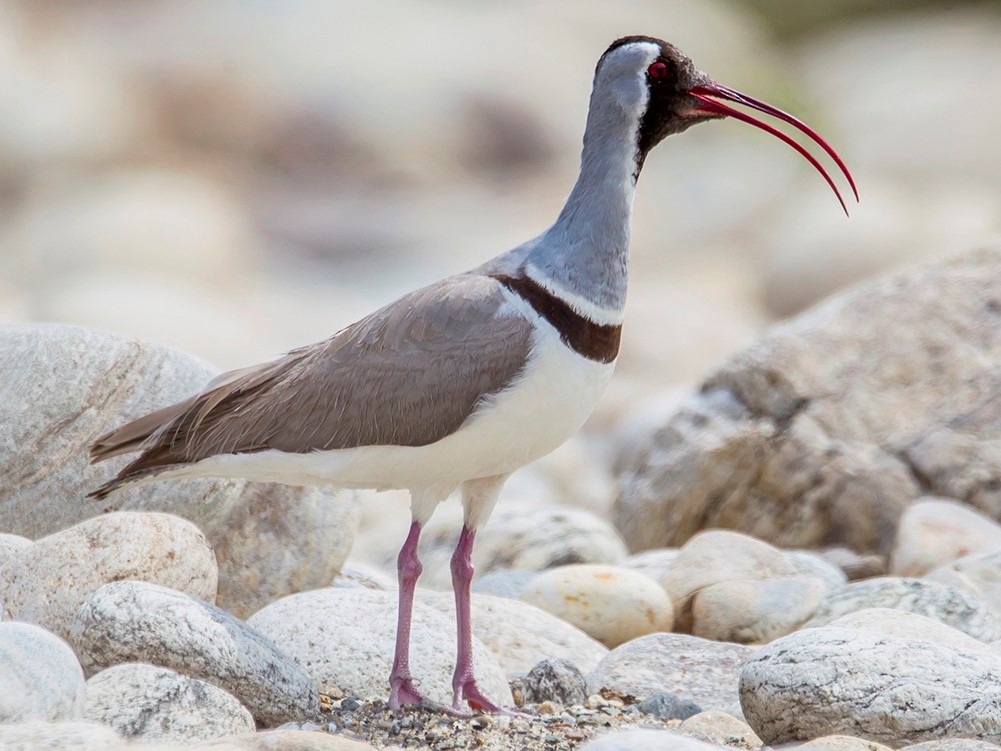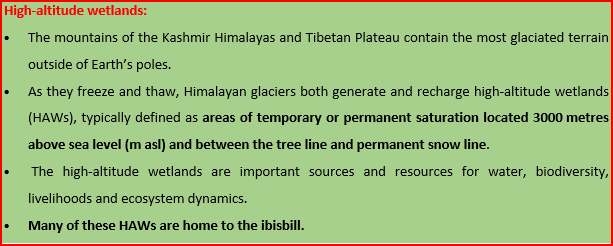Description

Disclaimer: Copyright infringement not intended.
Context: A study published in 2022 has documented several threats faced by the ibisbill species at six sites along the high-altitude Sindh River in Ganderbal district of Central Kashmir.
Details:
About the species:
- Scientific name: iIbidorhyncha struthersii
- Perfectly camouflaged against the boulder-strewn streams in its high-altitude habitat.
- It is known as the ‘wonder bird of the Himalayas’ owing to its elusive nature and rarity.
- The Ibisbill belongs to the order Charadriiformes which includes Plovers, Terns, Gulls and Sandpipers.
- The Ibisbill is a wading shorebird that breeds across southern Central Asia from Kazakhstan to North West China and south to North West India.
- There are no subspecies of Ibisbills.
.jpeg)
Distribution:
- Owing to its wide range, the ibisbill is recorded only in highly specialised riverine habitats and is a rare sight.
- Its population remains unknown across its range in southern Central Asia.
- In India, the bird has been recorded in Jammu and Kashmir, Ladakh, pockets of Uttarakhand and Sikkim, and a few sites in northeast India.

Ibisbill Behaviour:
- Ibisbills are vocal birds and produce a ringing ‘klew klew’ call. Like most shore birds in flight, the Ibisbill flys with its long neck out-stretched and its rounded wings extended outwards.
- Ibisbills are generally solitary birds particularly during Autumn and Winter although some may be found in small groups of 5 – 8 birds.
- Ibisbills breed solitary and are also known to be monogamous, pairing up with a single mate, sometimes for the duration of a breeding season.
Nesting: unlike other riverine birds, the ibisbill nests in small islands of the third-order streams (waterways in the upper reaches of the watershed) being interrupted with boulders and pebbles.
Conservation status: are listed as a species of ‘Least Concern’ in the IUCN Red List of Threatened Species.

Mining and other anthropogenic threats:
- The most frequently recorded human-caused disturbances impacting the bird and its habitat were mining and livestock grazing.
- The impact of large-scale boulder mining in Himalayan riverbeds on the species can be immense.
- The ibisbill is a habitat specialist and requires flowing streams and rivers with boulders where they can forage and also nest, and (being ground-dwelling species) use the boulders to effectively conceal themselves and their nests from predators. With boulders removed, their essential habitat is completely lost.
- Threats such as sand and boulder mining will not only impact nesting sites for breeding birds but also affect resources available to other birds which inhabit sandy river banks and large river islands.
Impact of Climate change:
- Besides anthropogenic pressures, experts emphasise that ground nesting birds including the ibisbill can be impacted by changing climatic patterns in Indian Himalayas.
- Erratic weather pattern in recent times is leading to a loss of nesting.
- Factors like the water level of the stream or river, temperature requirements during incubation, and the food resources available once the eggs hatch, could all be affected by climate change.

Way Forward:
- Protection measures have to be strategised based on the landscape rather than site specific.
- The ground-nesting birds require species-specific conservation management solutions.
- Detailed ecological studies focusing on their migration and habitat requirements are required to be taken up.
- This species is a flagship species of the high-altitude Himalayan rivers and the government of the Himalayan states including the Union Territory of Kashmir should initiate research and provide adequate, funding, support for this species.
- The first step towards conserving these unique habitat specialist birds is to spread awareness about their ecology and threats through human actions.
- Waste disposal has to be monitored closely.
|
PRACTICE QUESTION
Q) The impact of large-scale boulder mining in Himalayan riverbeds on the species can be immense. Examine in reference to flagship species such as ibisbill. (150 words)
|

https://www.moneycontrol.com/news/environment/ibisbill-the-poorly-understood-himalayan-waterbird-faces-threats-finds-study-10310121.html














